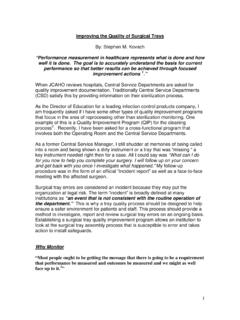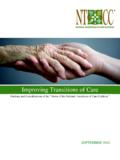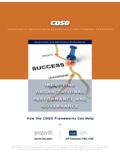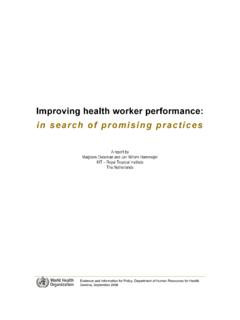Transcription of Improving the Quality of Parent-Child Contact in ...
1 InR. M. Galazter-Levy, J. Kraus, & J. Galatzer-Levy. (2009). The scientific basis of child custodydecisions. (Second edition). Hoboken, NJ: Wiley. (pp. 187-214)1 Improving the Quality of Parent-Child Contact in Separating Families withInfants and Young Children: Empirical Research FoundationsMichael E. Lamb and Joan B. KellySocial scientists in general, and psychologists in particular, largely agree thatparent-child relationships play a crucial role in shaping children s development andadjustment. As a result, considerable efforts have been made to examine thedevelopmental course of these relationships, the features ensuring that some relationshipshave more positive effects on children s development than others, and the effects ofparent-child separations and relationship disruptions on children s subsequentadjustment.
2 In this paper, we briefly summarize the relevant empirical literature, citingthe secondary rather than primary literature for the most part in order to minimize thelength and density of the text. We first discuss the development of infant- and child-parent relationships, and the factors that affect the strength and Quality of theserelationships. We then turn to research concerned with the effects of divorce on children,with special focus on the ways in which harmful effects can often be minimized bypromoting the maintenance of children s relationships with both of their divorcingparents. We have discussed many of these issues in some detail elsewhere (. , Kelly,2005, 2007; Kelly & Emery, 2003; Kelly & Lamb, 2000, 2003; Lamb, 2002a, 2002b, inpress; Lamb & Lewis, 2005; Trinder & Lamb, 2005) but this chapter provides our mostup-to-date statement.
3 Our goal is to provide those professionals conducting custodyevaluations or assessments with an underlying empirical foundation for understandingand weighing the many complex issues seen in separating families, including those inwhich parents are disputing custody and access arrangements. Knowledge of the socialscience literature also provides evaluators and other professionals with a sound basis forformulating and defending recommendations regarding children s living arrangements tothe court if such recommendations are expected or requested (Kelly & Johnston, 2005).THE DEVELOPMENT OF Parent-Child RELATIONSHIPSK elly and Lamb (2000), among others, have documented how an understandingof normative developmental phases informs both our understanding of the ways in whichparental separation and divorce may affect children s development and adjustment aswell as the design of post-divorce living arrangements most likely to benefit children.
4 Asdescribed by Bowlby (1969), and largely confirmed by subsequent research (for detailedreview, see Thompson, 2006), Kelly and Lamb (2000) recounted how infant-parentattachments pass through four broad developmental phases, during the first three ofwhich infants learn to discriminate among adult carers and gradually develop emotionalattachments to the first two months (phase 1), infants indiscriminately accept care from anycarer and use a repertoire of innate signals, including crying and smiling, to bring andInR. M. Galazter-Levy, J. Kraus, & J. Galatzer-Levy. (2009). The scientific basis of child custodydecisions. (Second edition). Hoboken, NJ: Wiley. (pp. 187-214)2keep potential carers close to them.
5 The relief of distress from hunger or pain and thegrowing interest in and response to social signals from adults are the building blocks formore discriminating attachment processes but regular interaction is needed to continuethe process of attachment formation because infants at this age have very primitivememories and cognitive the period extending from 2 to 7 months of age (phase 2), infants increasinglybegin to recognize their parents and other carers and to prefer interaction with them. Theyalso begin to anticipate carers responses to their signals although they do not yetunderstand that people (including carers) continue to exist when they are not of this age initiate and enjoy social interactions and start to show signs of attachment in the making.
6 They do not yet typically protest separations from theirparents, but require frequent Contact with their parents for attachment formation tocontinue. Importantly, research has shown that fathers are as competent to care for theirinfants and toddlers as mothers, given comparable opportunities and experiences (Lamb,1997, 2002a; Parke, 1996).In the third phase of attachment development (between 7 and 24 months),attachments become increasingly apparent, as infants preferentially seek to be near and tointeract with specific carers, by whom they are more easily soothed than by to Bowlby s initial speculation and widespread common sense , there isconsiderable evidence that most infants in two parent families do not become attached totheir mothers first but rather form attachments to both parents at about the same age,around 6 to 7 months (see Lamb, 2002a, for a review) even though fathers typicallyspend less time with their infants than mothers do (Pleck & Masciadrelli, 2004).
7 Thisindicates that, although a threshold level of interaction is crucial for attachments to form,time spent interacting is not the only critical begin to protest when separated from their primary attachment figuresaround 6 to 7 months of age, react warily to strangers, and, in a rudimentary way, startrecognizing that parents continue to exist even when they are not present. Over theensuing months, infants and toddlers become able to tolerate longer separations fromtheir parents or attachment figures, although such separations may remain stressful. Mostinfants come to prefer the parents who take primary responsibility for their care(typically their mothers), but this does not mean that relationships with their less-involved parents are unimportant.
8 In fact, many toddlers and preschoolers seem to prefer their traditional fathers, especially when they are not stressed or tired (Lamb,2002a). The amounts of time that infants spend with their two parents does not appear todetermine whether or not the attachment relationships with either are insecure or , the relative prominence of the two parents in caring for and interacting withtheir children does appear to affect the relative importance of the two relationships withrespect to their impact on later development. Specifically, the relationship with the moreinvolved parent tends to have a greater impact than the relationship with the less involvedparent, albeit not clearly in direct proportion to the relative levels of M.
9 Galazter-Levy, J. Kraus, & J. Galatzer-Levy. (2009). The scientific basis of child custodydecisions. (Second edition). Hoboken, NJ: Wiley. (pp. 187-214)3 Nonetheless, both relationships remain psychologically important even when there aredisparities in the two parents levels of participation in child to attachment theorists, infants form attachments to those who havebeen available regularly and have responded to the infants signals and needs (Lamb,Thompson, Gardner, & Charnov, 1985; Thompson, 2006). All carers are notequivalently sensitive, of course, and individual differences in responsiveness affect thequality or security of the attachment relationships that form. The Quality of both maternaland paternal behavior is reliably associated with the security of infant-parent attachment(DeWolff & Van IJzendoorn, 1997; Van IJzendoorn & DeWolff, 1997).
10 Interestingly,the association between the Quality of paternal behavior and the Quality of infant-fatherattachment appears to be weaker than the parallel association between maternal behaviorand the security of infant-mother attachment. However, the Quality of both mother- andfather-child interaction remains the most reliable predictor of individual differences inpsychological, social, and cognitive adjustment in infancy, as well as in later childhood(Lamb & Lewis, 2005; Thompson, 2006).According to Yarrow (1963; Yarrow & Goodwin, 1973), separation responses ofinfants become increasingly intense as attachments to parents and other important carersstrengthen between 6 and 24 months. As mentioned earlier, most infants initially preferthe parent who provides most of their care and are more likely to seek out their preferredparents for comfort when distressed (see Lamb, 2002a, for a review).









